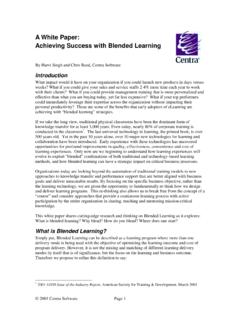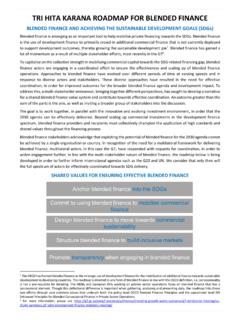Transcription of Design of the Blended Wing Body Subsonic Transport
1 JOURNALOFAIRCRAFTV ol. 41, No. 1, January February 2004 Design of the Blended wing body Subsonic T ransportR. H. Liebeck The Boeing Company, Huntington Beach, California 92647 The Boeing Blended - wing body (BWB) airplane concept represents a potential breakthrough in Subsonic trans-port ef ciency. Work began on this concept via a study to demonstrate feasibility and begin development of thisnew class of airplane. In this initial study, 800-passenger BWB and conventional con guration airplanes were sizedand compared for a 7000-n mile Design range.
2 Both airplanes were based on engine and structural (composite)technology for a 2010 entry into service. Results showed remarkable performance improvements of the BWB overthe conventional baseline, including a 15% reduction in takeoff weight and a 27% reduction in fuel burn per seatmile. Subsequent in-house studies at Boeing have yielded the development of a family of BWB transports rangingfrom 200 to 600 passengers with a high level of parts commonality and manufacturing ef ciency.
3 Studies havealso demonstrated that the BWB is readily adaptable to cruise Mach numbers as high as The performanceimprovement of the latest Boeing BWBs over conventional Subsonic transports based on equivalent technology hasincreased beyond the predictions of the early NASA-sponsored IntroductionIT is appropriate to begin with a reference to the Wright Flyeritself, designed and rst own in 1903. A short 44 years later,the swept- wing Boeing B-47 took ight.
4 A comparison of these twoairplanes shows a remarkable engineering accomplishment within aperiod of slightly more than four decades. Embodied in the B-47 aremost of the fundamental Design features of a modern Subsonic jettransport: swept wing and empennage and podded engines hung onpylons beneath and forward of the wing . The Airbus A330, designed44 years after the B-47, appears to be essentially equivalent, asshown in Fig. , in 1988, when NASA Langley Research Center s DennisBushnell asked the question: Is there a renaissance for the long-haul Transport ?
5 There was cause for re ection. In response, a briefpreliminary Design study was conducted at McDonnell Douglas tocreate and evaluate alternate con gurations. A preliminary con gu-ration concept, shown in Fig. 2, was the result. Here, the pressurizedpassenger compartment consisted of adjacent parallel tubes, a lateralextension of the double-bubble concept. Comparison with a con-ventional con guration airplane sized for the same Design missionindicated that the Blended con guration was signi cantly lighter,had a higher lift to drag ratio, and had a substantially lower paper is intended to chronicle the technical development ofthe Blended - wing body (BWB) concept.
6 Development is brokeninto three somewhat distinct phases: formulation, initial develop-ment and feasibility, and, nally, a description of the current BoeingBWB baseline Formulation of the BWB ConceptThe performance potential implied by the Blended con gurationprovided the incentive for NASA Langley Research Center to funda small study at McDonnell Douglas to develop and compare ad-vanced technology Subsonic transports for the Design mission of 800passengers and a 7000-n mile range at a Mach number of Com-posite structure and advanced technology turbofans
7 Were ning the pressurized passenger cabin for a very large airplaneoffers two challenges. First, the square-cube law shows that the cabinReceived 9 June 2002; revision received 19 December 2002; acceptedfor publication 10 January 2003. Copyrightc 2003 by the American In-stitute of Aeronautics and Astronautics, Inc. All rights reserved. Copies ofthis paper may be made for personal or internal use, on condition that thecopier pay the $ per-copy fee to the Copyright Clearance Center, Inc.
8 ,222 Rosewood Drive, Danvers, MA 01923; include the code 0021-8669/04$ in correspondence with the CCC. Boeing Senior Technical Fellow, Phantom Works. Fellow area per passenger available for emergency egress decreaseswith increasing passenger count. Second, cabin pressure loads aremost ef ciently taken in hoop tension. Thus, the early study beganwith an attempt to use circular cylinders for the fuselage pressurevessel, as shown in Fig. 3, along with the corresponding rst cutat the airplane geometry.
9 The engines are buried in the wing root,and it was intended that passengers could egress from the sides ofboth the upper and lower levels. Clearly, the concept was headedback to a conventional tube and wing con guration. Therefore, itwas decided to abandon the requirement for taking pressure loadsin hoop tension and to assume that an alternate ef cient structuralconcept could be developed. Removal of this constraint becamepivotal for the development of the cabin de nition became the origin of the Design , withthe hoop tension structural requirement deleted.
10 Three canonicalforms shown in Fig. 4a, each sized to hold 800 passengers, wereconsidered. The sphere has minimum surface area; however, it isnot streamlined. T wo canonical streamlined options include the con-ventional cylinder and a disk, both of which have nearly equivalentsurface area. Next, each of these fuselages is placed on a wing thathas a total surface area of 15,000 ft2. Now the effective masking ofthe wing by the disk fuselage results in a reduction of total aerody-namic wetted area of 7000 ft2compared to the cylindrical fuselageplus wing geometry, as shown in Fig.





